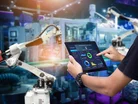Automation is the real hero of the COVID-19 pandemic

John Payne is the Chairman of the Board of the Association for Advancing Automation (A3), North America’s largest automation trade association representing more than 1,100 organizations involved in robotics, artificial intelligence, machine vision & imaging, motion control & motors and related automation technologies. John knows that the COVID-19 pandemic response has relied heavily on automation, accelerating its adoption across the global supply chain.
Here, he shares some thoughts on automation in healthcare.
Automation and the fight against COVID-19
When COVID-19 began to spread in 2020, one of the first challenges society faced was the urgent need to exponentially increase the volume of personal protective equipment. Manufacturers heeded the call, producing billions of face masks and other equipment to protect health care workers. The 3M corporation alone produced 2.5bn face masks in 2021, according to a BBC report.
Next came COVID tests, required urgently in staggering quantities. The United States alone has performed more than 825mn tests since they became available in March 2020. The vaccination campaign produced similarly staggering numbers with 10.8bn doses having been administered since the start of the pandemic.
There were also subtler changes which took place in manufacturing such as the rapid shift from bulk packaging to individual serving packages. All these incredible production accomplishments were made possible by automation. Without automation it simply would not have been possible to achieve the response we have all seen to the pandemic.
Automation manufacturing in healthcare
All of these feats were made possible by the four main areas of automation: robotics, motion control, vision and artificial intelligence.
Robotics, the most recognisable technology, is widely used in packing and logistics. Manufacturers are utilising robots to package goods in boxes and cases, build pallets for shipment and load trust. Robots have been critical in addressing the growing labour shortages and ensuring proper social distancing in essential workplaces.
Motion Control is at the core of most automated machinery. Modern servo control is highly adaptive to changing demands. For example, the case of a large US snack foods producer seeking to shift the balance of their production away from large bulk bags to individual serving sides all using the same equipment. By designing the machines for flexibility initially and relying on the advanced computer controls now widely in use the production output could be readily shifted to meet the sudden change in demand for package size. The same can be applied for items like home test kits, which began as single-test packages but had to adapt to dual-test packages on short notice.
Machine Vision is critical for production liability. For example, consider the rigorous quality control required for medical products, test kits and vaccines. With machine vision, manufacturers can detect production defects in real time, which allows for greater reliability and high volumes. Similarly, utilising advanced sensor technology allows for a production line to identify defects, make corrections and ensure high volume output with minimal loss.
Then, of course, is the growing adoption of machine learning to optimise each of the technologies above. Manufacturers who use machine learning are able to more easily adapt to slight variations in production environments and respond quickly to changes in production demand.
Each of these technologies has played - and continues to play - a critical role in supporting the global COVID response, while also supporting the economic infrastructure on which billions of people depend.
As we approach two years since the onset of the pandemic, that infrastructure is under significant stress, exposing the vulnerability of our global supply chain. As the chairperson of the Association for Advancing Automation, I believe that the answer to achieving low costs while protecting against disruption is automation. Our growth as an industry, sector and country will be driven by advancements in automation, robotics and machine vision and learning technologies.
Byline written by John Payne, the Chairman of the Board of the Association for Advancing Automation

